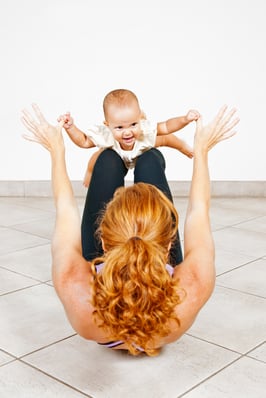 The baby has arrived! Congratulations! You just completed the toughest thing on the face of the Earth (at least in my opinion). You so graciously shared your body for up to 40 weeks and endured all the highs and lows that come with being pregnant. Now comes the not so fun part, trying to get that baby weight off. Unfortunately, I think in today’s society there is so much pressure on moms to get back to their “post baby body” as quickly as possible. This pressure can often cause unrealistic goal setting which leads to frustration when you struggle to get back to where you were before the baby arrived.
The baby has arrived! Congratulations! You just completed the toughest thing on the face of the Earth (at least in my opinion). You so graciously shared your body for up to 40 weeks and endured all the highs and lows that come with being pregnant. Now comes the not so fun part, trying to get that baby weight off. Unfortunately, I think in today’s society there is so much pressure on moms to get back to their “post baby body” as quickly as possible. This pressure can often cause unrealistic goal setting which leads to frustration when you struggle to get back to where you were before the baby arrived.
For me, one of the hardest things I’ve had to learn as a new mom has been taking my time to get back to where I was. I am currently six months post baby and have finally realized that my body (and lack of sleep!!) is going to be different than it was before. Listening to your body, learning patience and body acceptance is one of the best things you can do for yourself during this transition. Below I’ve listed several postpartum exercises that are great for easing back in to mild activity; they should help build the foundation for establishing a regular exercise program. Of course, always seek advice from your doctor before beginning any exercise program.
Walking, walking, walking! I used to HATE walking for exercise. I would much rather run. I thought if I wasn’t sweating and breathing heavily, I wasn’t getting a good workout. WRONG. Walking is your best friend before, during and after pregnancy. Even if you can only walk for 10 minutes and at a slow pace, do it. This will help you become familiar with your body again. You can still reap the benefits of cardiovascular health through walking, with a decreased risk of injury or overtraining. This is also an activity that you can incorporate with your newest addition if you’d like – a good walking/jogging stroller is a great investment!
Pelvic Tilts. That baby of yours took up a lot of room in your abdominal cavity and so graciously stretched its limits, so this exercise is going to improve your abdominal strength and stamina. It may also help you improve posture which can be changed during and after pregnancy. Start by lying on the floor on your back with your knees bent and your feet flat on the floor. Flatten you lower back against the floor by tightening your abdominal muscles and then begin tilting your pelvis up slightly. Exhale and repeat. Continue for 10-15 reps, several times a day.
Pelvic Bridges. There’s a good chance you learned about pelvic bridges while you were pregnant and I’m here to tell you to keep doing them! This exercise is a great way to strengthen your quadriceps, hamstrings, abdominals and glutes. It can also help stabilize your hips, which often become relaxed and soft to allow the baby to pass through during labor. Begin in the same starting posture for a pelvic tilt, resting your arms by your side, inhale and raise your pelvis off the floor while squeezing your buttocks. Exhale and lower your pelvis and lower back down to the floor. Start out with 6-10 repetitions holding them 5-10 seconds.
Remember, how the tortoise won the race? Slow and steady. That’s going to be your motto for the next few weeks (or months) as you maneuver your post pregnancy health and that’s okay. Your body created another human life and just for that you should be so proud of yourself! Sneak in whatever workout you can during this busy transition into motherhood. Stay positive and remember to love yourself and your new body. Congrats, mama!

